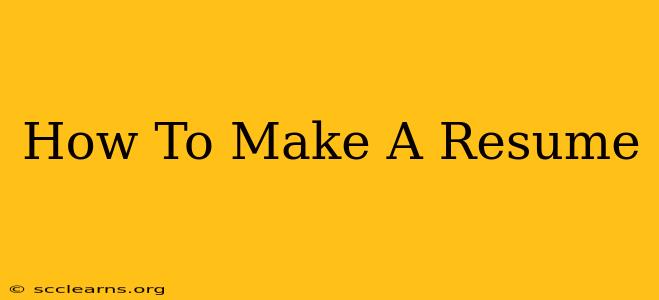Landing your dream job starts with a compelling resume. This guide will walk you through crafting a resume that not only showcases your skills and experience but also grabs the attention of recruiters and hiring managers. We'll cover everything from choosing the right format to highlighting your accomplishments effectively.
Choosing the Right Resume Format
The first step is selecting a format that best presents your qualifications. There are three main types:
1. Chronological Resume:
This classic format lists your work experience in reverse chronological order, starting with your most recent job. It's ideal if you have a consistent work history and want to emphasize career progression.
Advantages:
- Easy to read and understand.
- Highlights career progression.
- Best for candidates with a steady work history.
Disadvantages:
- Can highlight employment gaps.
- Less effective for career changers.
2. Functional Resume:
This format emphasizes your skills and abilities rather than your work history. It's a good choice if you're changing careers, have gaps in your employment, or want to highlight specific skills.
Advantages:
- Highlights skills and accomplishments.
- Ideal for career changers or those with employment gaps.
- Focuses on relevant skills.
Disadvantages:
- Can be perceived as hiding employment history.
- Requires strong skills summary.
- Less common than chronological resumes.
3. Combination Resume:
This format combines elements of both chronological and functional resumes. It allows you to showcase both your skills and your work experience. This is often a versatile option for many job seekers.
Advantages:
- Highlights both skills and experience.
- Versatile and adaptable to various situations.
- Balances skills and career progression.
Disadvantages:
- Can be longer than other formats.
- Requires careful organization to avoid appearing cluttered.
Crafting Compelling Content: Key Sections
Regardless of the format you choose, your resume should include these key sections:
1. Contact Information:
- Name: Use a professional and easily readable font size.
- Phone Number: Provide a reliable number where you can be easily reached.
- Email Address: Use a professional-sounding email address.
- LinkedIn Profile URL (Optional): Include if your profile is up-to-date and relevant.
- Location: City and State are usually sufficient; you don't need to include your full address for privacy reasons.
2. Summary/Objective Statement (Optional):
A strong summary statement concisely highlights your key skills and experience, tailored to the specific job you're applying for. An objective statement outlines your career goals. Choose one that best suits your situation.
Example Summary: Highly motivated marketing professional with 5+ years of experience in digital marketing, proven success in increasing brand awareness and driving sales. Seeking a challenging role in a dynamic environment.
3. Skills Section:
List your hard skills (technical abilities) and soft skills (interpersonal abilities). Tailor this section to the job description, highlighting the skills most relevant to the position. Consider using keywords from the job posting.
4. Work Experience:
Use the reverse chronological order (most recent first). For each role, include:
- Job Title:
- Company Name:
- Dates of Employment: (Month/Year – Month/Year)
- Responsibilities and Accomplishments: Use action verbs and quantify your achievements whenever possible. Focus on results, not just tasks. Use the STAR method (Situation, Task, Action, Result) to structure your descriptions.
5. Education:
List your degrees, certifications, and relevant coursework. Include the institution name, degree earned, major, graduation date (or expected graduation date), GPA (optional, include only if above 3.5), and any relevant honors or awards.
6. Additional Sections (Optional):
Depending on your experience and the job requirements, you might include sections such as:
- Projects: Showcase personal projects or volunteer work.
- Awards and Recognition: Highlight any achievements.
- Publications: List any publications or presentations.
- Languages: List any languages you speak fluently.
Tips for Resume Success:
- Keywords are Key: Incorporate relevant keywords from the job description throughout your resume.
- Quantify Your Accomplishments: Use numbers and data to demonstrate your impact.
- Proofread Carefully: Errors can make a negative impression. Have someone else proofread it as well.
- Tailor Your Resume: Customize your resume for each job application.
- Use a Professional Font: Choose a clean and easy-to-read font like Times New Roman, Arial, or Calibri.
- Keep it Concise: Aim for one page, especially if you have less than 10 years of experience.
By following these steps, you can create a resume that effectively highlights your qualifications and increases your chances of landing an interview. Remember, your resume is your first impression – make it count!

